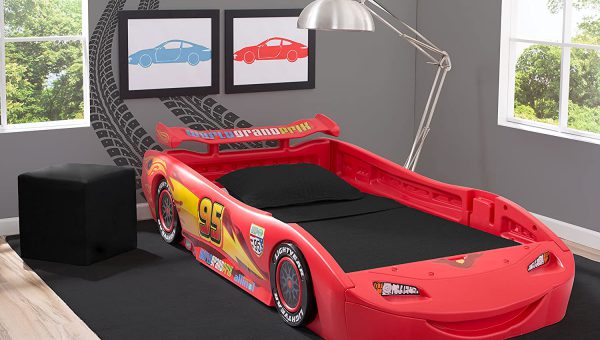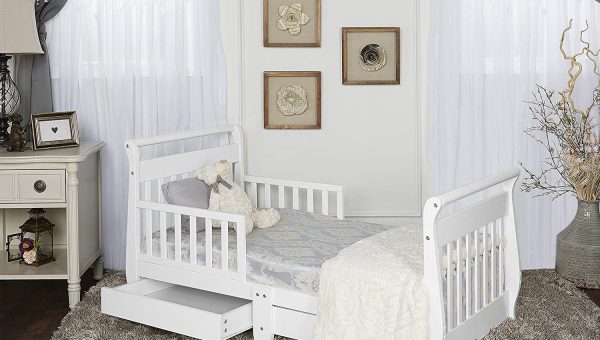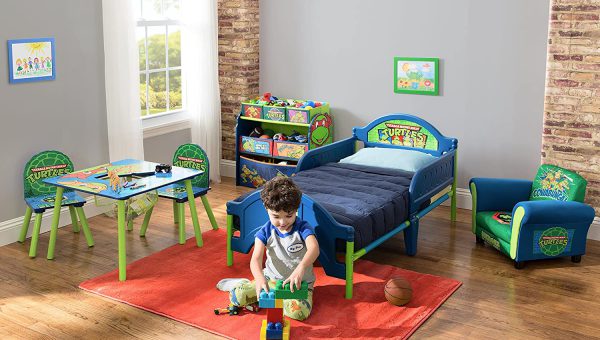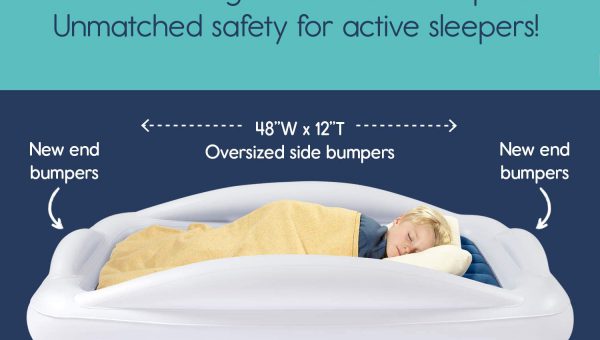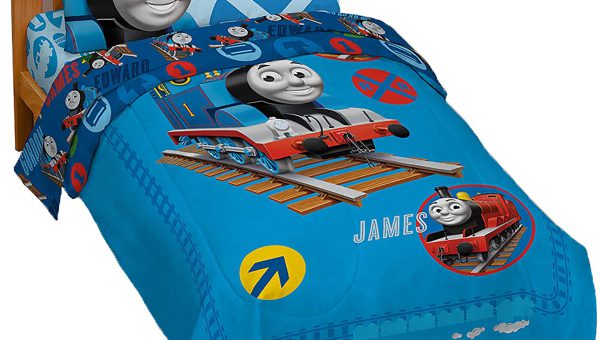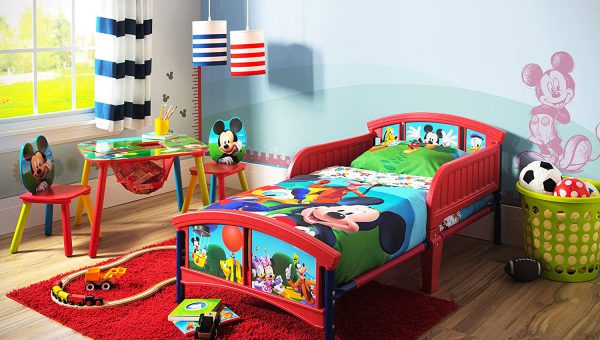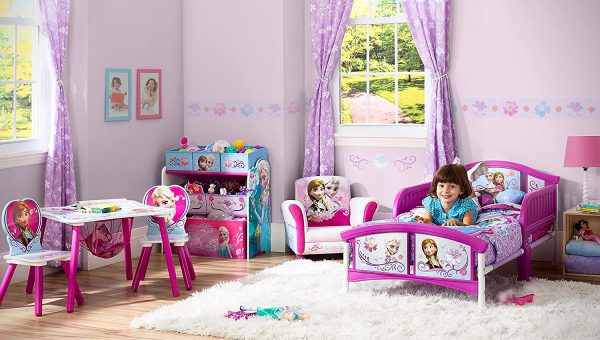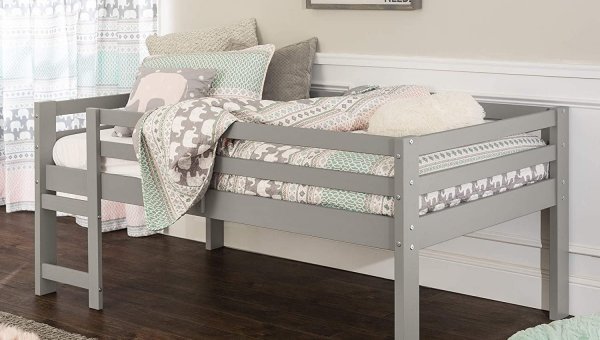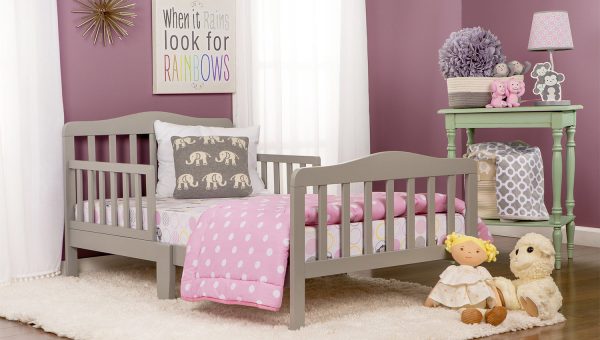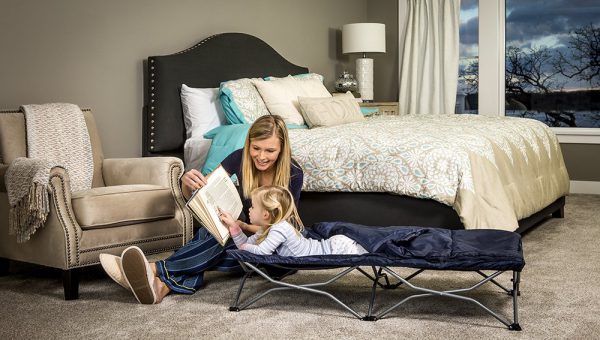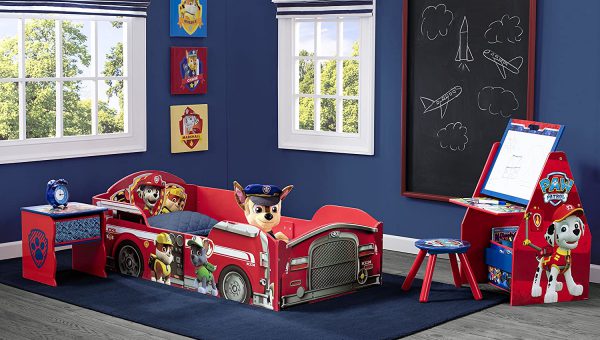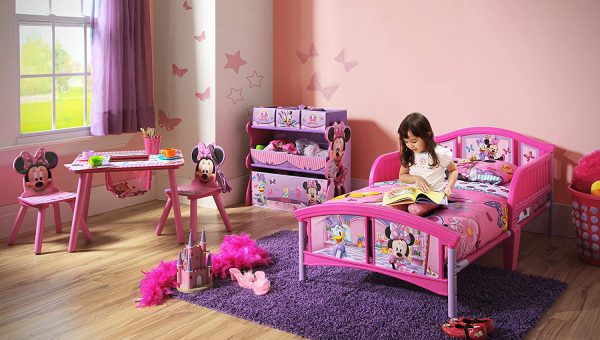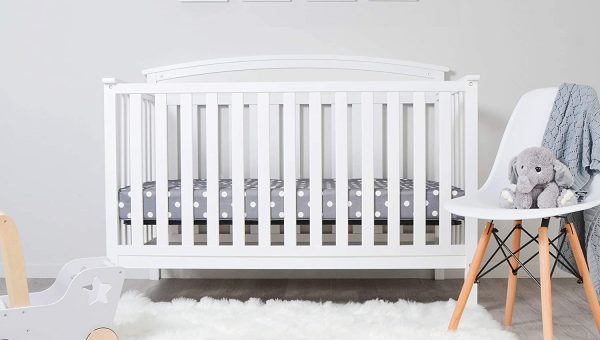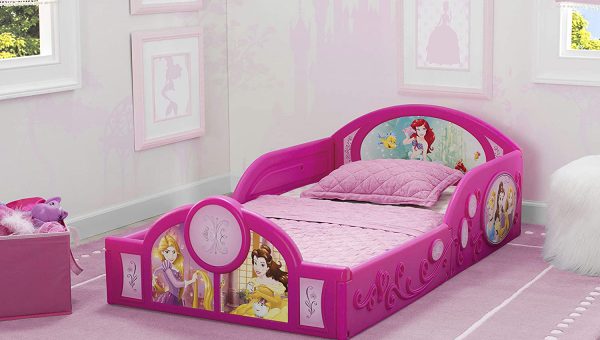Toddler Beds
Let’s face it, babies grow and mature pretty quickly. That is something every parent needs to grapple with early on. And soon enough, your child would need to leave the crib and switch to a toddler bed.
Don’t just dive right into buying, though. Do your homework first. After all, there are endless options in the market. It is easy to get overwhelmed and end up buying the wrong product. If so, you might compromise your child’s comfort and safety, which is the last thing you want. Here, we give you an overview of how to choose the best toddler bed for your bundle of joy.
Toddler Beds: What You Need to Know
A toddler bed is simply a small bed designed for toddlers or little children between the ages of one and three years. This type of bed has low side rails, as opposed to cribs, which are fully enclosed. It is also built close to the ground. These features enable your child to safely access the bed even without assistance. Another thing to note is that it typically uses the same mattress as a crib.
There is no definitive answer on when your child should move to a toddler bed. Many do so anytime between eighteen months and two years, while others may take up to four years of age.
As a rule of thumb, consider making the switch when your kid is old enough to try escaping from the crib. If left alone, it is just a matter of time before they get injured. In some cases, the crib might simply be too cramped for your growing child. Another practical reason to buy a toddler bed is when a new baby is on the way.
Your child becomes too tall for the toddler bed upon reaching five to seven years of age. That is the time to transition to a twin-sized or regular bed.
What Are the Different Types of Toddler Beds?
There are several types of toddler beds. Each comes in varying sizes, shapes, styles, and features. Generally, they can be grouped into five categories, including:
- Themed toddler beds
- Toddler beds with storage
- Toddler loft beds
- Portable toddler beds
- Inflatable toddler beds
With so many products available, choosing the toddler bed for your kid is no easy feat. Fortunately, knowing the different types of toddler beds, including their most notable characteristics, can help you with the decision-making process.
1. Themed Toddler Beds
Themed toddler beds, as the name indicates, follow a unique theme and come in dreamy, whimsical designs, making bedtimes more exciting for every child. For example, the bed may assume the form of a truck or a race car. Or, it might have features fit for royalty, such as a canopy, sheer curtains, or elegant colors. Another option is a toddler bed decorated with cartoon characters from popular television series or films, such as Disney princesses, Mickey Mouse, PAW Patrol, and Thomas the Train.
2. Toddler Beds with Storage
Also known as “captain beds,” storage toddler beds are among the most popular types of big kid beds, especially among parents who prefer multipurpose furniture. These come with built-in compartments, usually in the form of large drawers under the bed, where you can keep linens, pillowcases, clothes, and other bits and bobs. Alternatively, some might have bookshelves or toy chests on the headboards or foot-boards. Aside from helping save precious space, toddler beds with storage also teach little ones about being organized early on.
3. Toddler Loft Beds
Toddler loft beds are the ultimate space-saving solution for small rooms, making it yet another crowd-favorite among parents. Versatile and multifunctional, it features a slightly raised bed and an extra space directly underneath. This under-bed area, in turn, can be fashioned into a mini playroom, desk, or shelf, among others. Since this type of bed typically comes in fun and quirky styles, it is an instant hit among toddlers as well. Due to safety issues, however, it is better suited for older kids.
4. Portable Toddler Beds
Portable toddler beds are recommended if you are about to go on a family vacation – or if your little one is sleeping over at Grandma’s. They come in various types and styles, but foldable cots and sleeping bags are among the most common. Essentially, their goal is to ensure that your kid could have sound, comfortable slumbers even while home away from home. On top of that, portable toddler beds are also convenient. Being light and compact, they are easy to lug around and won’t take up a lot of space in the car.
5. Inflatable Toddler Beds
Inflatable toddler beds are a type of portable toddler bed. Typically, they are made of polyvinyl chloride (PVC), thermoplastic polyurethane (TPU), or rubber, and may come in various shapes and styles. Ideal for sleepovers and travels, this temporary bed is inflated with a pump before use. Meanwhile, when not in use, the mattress is deflated, then rolled up or folded for effortless storage.
How Do You Choose a Toddler Bed?
There are five things you need to keep in mind when buying a toddler bed. It includes visual appeal, comfort, safety, convenience, and value for money. Having a full grasp of these factors can help you single out the ultimate toddler bed for your kid – one that meets their needs, preferences, and personality. At the same time, the bed also needs to be beneficial for you, and that includes being convenient and cost-effective.
1. Visual Appeal
Toddlers are learning to express their preferences, so make sure to opt for a bed that appeals to their tastes. For example, it could feature their favorite designs, colors, fictional characters, or animals. Essentially, the more appealing the toddler bed, the more psyched up your child will be to settle into it. Be careful not to make the bed too exciting, though. Otherwise, your kid might be excessively enthusiastic and refuse to sleep.
2. Comfort
Being visually striking is not enough. A toddler bed should also promote a warm, comfortable sleeping environment. After all, your kid would spend up to 14 hours per day dozing off in the new bed. More importantly, it also has to remain comfy as your child continues to grow.
- Snug fit for the mattress. In general, toddler beds require a standard crib mattress. Nonetheless, check the dimensions of the bed first – and ensure that the mattress would fit inside it perfectly. If not, you would have to remedy it in one way or another. Any wiggle room is unsafe as it could cause your child to slip or get stuck in the gap.
- Weight capacity. Before purchasing, check the maximum weight holding capacity of the bed. Most beds could support up to 50 pounds. Remember, your kid is growing and will be gaining weight in the coming months. You would have to take that into account.
- Allows room for growth. Aside from getting heavier, your child will also get taller by several inches. Make sure that the bed could accommodate your toddler’s vertical growth during this transitional age.
3. Safety
Safety comes hand in hand with comfort. By and large, it boils down to the material used and how well the bed was constructed.
- Low height. Make sure that the bed is low-to-the-ground. Remember, toddlers like climbing in and out of the bed on their own. Being close to the floor facilitates safe entry and exit while minimizing the impact of falls.
- Guardrails. Look for a toddler bed that has attached side rails. These ensure that little ones stay inside the bed, especially if they tend to turn or toss about in their sleep.
- Material and construction. An infant bed is typically made of wood, plastic, or steel. Whatever material you choose, ensure that it is high-quality, sturdy, and devoid of toxic ingredients, including latex, lead, phthalates, and BPA. And, make sure that the bed has rounded corners and no protruding parts to avoid unwanted poking and other injuries.
- Stability and durability. By itself, sturdy material is not enough. The assembled bed has to be stable and structurally sound, too. If using a metal frame, for example, make sure that the screws are tight and secure. More importantly, it also needs to withstand years of use and activity. It ensures that the frame won’t wobble or collapse later on, which could potentially harm your child.
- Certification seal. Ideally, the toddler bed should have the Juvenile Products Manufacturers Association (JPMA) certification. It guarantees that the bed meets the strictest standards for quality, safety, performance, and functionality, giving you peace of mind.
4. Convenience
An excellent toddler bed should not only be advantageous to your child – but to you as well. First, ensure that the bed is reasonably easy to set up. No one wants to spend endless hours trying to figure out how to put together the bed frame. Consequently, the assembled bed should be fuss-free to clean and maintain, especially in the case of wetting accidents during the night.
How can you tell if the toddler bed satisfies these requirements? One way is to sift through the product reviews online. It would give you an idea about others’ experiences with the bed, including its assembly and performance over time.
5. Value for Money
Childhood products can get pretty expensive. Even so, make sure not to cut corners. We are talking about your toddler’s comfort and safety here. It might be tempting to buy that ridiculously cheap secondhand bed then and there – but think about it first. After all, who knows if it could still endure a few more years of use?
If you are on a budget, the workaround is to opt for a product that would provide the most bang for your buck.
- Warranty. Make sure that the chosen bed comes with a warranty certificate. You never know when a part of the bed would be broken and require a replacement. Manufacturers usually offer ninety-day warranties, but others might have up to a year.
- Convertible. Toddler beds are merely transitional beds. While mostly used for at least a few years, other kids outgrow them in just a matter of months. It is especially true when they transition to a toddler bed much later than usual. In this case, consider designs that convert to a twin bed, which saves you from the expense of buying an entirely new bed later on.
- Added features. Some beds more than just provide a sleeping environment. Storage toddler beds, for instance, often come with spacious drawers, eliminating the need for extra closets. You do not only save space but precious bucks as well.
- Durability. Wood, by far, is the sturdiest construction material for toddler beds. While they tend to be pricier, you can rest assured that it would last for many years, making it cost-effective in the long run. A durable toddler bed is also highly recommended if you plan on having more kids in the future. This way, you could just pass on the bed to your younger kids instead of buying a new one.
A final word: quality does not necessarily have to be expensive. Several tried-and-tested brands offer budget-friendly toddler beds without compromising your child’s safety and comfort. In the end, it all comes down to doing your research before making a purchase.
Types of Toddler Beds
Cars Toddler Beds
Parents want to provide only the best for their beloved tots. And during toddler-hood, it means moving them from the crib to a safe, comfortable ...
Read MoreToddler Beds With Storage
Are you short on space but desperately need a new bed for your growing child? You might want to take a look at toddler beds ...
Read MoreNinja Turtles Toddler Beds
Moving your dearest child to a toddler bed is a significant milestone. Unfortunately, toddlers are often temperamental and highly resistant to change. For this reason, ...
Read MoreInflatable Toddler Beds
When in an unfamiliar place, toddlers often find it hard to fall asleep. If the bed is unappealing or downright uncomfortable, they might not even ...
Read MoreThomas The Train Toddler Beds
Is your growing child ready to move to a big kid bed, aka a toddler bed? You might have heard of stories about how difficult ...
Read MoreMickey Mouse Toddler Beds
Toddlers are the joy of every parent’s life. Naturally, you want to make sure that they are safe and secure at all times. That includes ...
Read MoreFrozen Toddler Beds
Babies grow pretty fast. Before you realize it, your bundle of joy has already outgrown the crib, requiring a new sleeping space. To make the ...
Read MoreToddler Tent Beds
During toddlerhood, your child will start engaging in imaginative and pretend play. Appeal to their creative side by getting a toddler bed tent. This type ...
Read MoreToddler Loft Beds
Loft beds are all the rage these days – and unsurprisingly so. After all, they are beautifully crafted, functional, and space-saving. On top of that, ...
Read MoreDream On Me Toddler Beds
When one says baby and toddler products, Dream On Me is one of the brands that first come to mind. Since 1988, this family-owned business ...
Read MorePortable Toddler Beds
About to go on vacation? Family camping? Or maybe your child is sleeping over at Grandma’s? Whatever the reason, your toddler will certainly need some ...
Read MorePAW Patrol Toddler Beds
Time sure does fly, and soon enough, your baby will need more than a crib – one that is not only cozy but also safe. ...
Read MoreMinnie Mouse Toddler Beds
During toddlerhood, the little ones are moved to a new sleeping space. Minnie Mouse toddler beds can make this transition easier. Upon seeing the beloved ...
Read MoreToddler Bed Mattresses
After buying a toddler bed for your bundle of joy, what comes next? If the bed does not come with a mattress, then you should ...
Read MorePrincess Toddler Beds
Struggling to get your growing toddler to leave the crib? Do they happen to be a massive fan of Disney Princesses? Perhaps they just like ...
Read More
